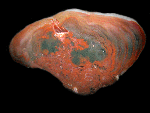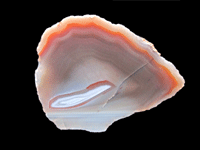
St Cyrus
St Cyrus is where it all began for me. Imagine an incredibly stormy day back in 1996. My younger brother and I were quite used to family trips to Barras Quarry by then, we knew it well. This, however, was an entirely new experience. Picture ominous thrashing waves, throwing voluminous drifts of brown-black seaweed over the yellow sand, while skeins of rain saturated our clothing. As I recall, on that first excursion, we didn't find a thing.
Over the years since, St Cyrus has become my favourite location. It has a pleasant air, an intriguing history and the agates found here can be unique.
The agates found in this location show an enormous variety of types in a small area. Of course, fortification and to a lesser extent water-level or onyx agates predominate, however we also encounter many other variations that punctuate these familiar patterns. There are myriad species of moss agates, occasionally in bright yellows or oranges. Plume-like moss agates occur too, displaying strings of seaweed-like growths in random array springing from the edges of the agate, initially appearing as irregular stalactites (see above) Many of the local fortification and onyx agates include moss, tube or stalactitic patterns to a varying extent in the edges of the nodule. Sagenitic agates are also to be found, albeit more rarely. Stalactitic agates here tend to the monchrome, however I have at least one example in grey shot-through with red/orange pigment platelets, so I am holding-out hope for more strongly coloured examples. Stalactitic agates here can also be very finely marked, combining on occasion with fortification patterns. If larger stones are discovered that are not mostly quartz (ranging from 6-7cm), often these are dark grey-blue, occasionally with areas of almost violet or purple, incorporating the aforementioned orange-pink-red pigment platelets. The patterns in these larger agates, if fortification is their general persuasion, can be unusual and unique to the area, showing large stalactites, large central tubes that appear as an eye in the centre with the banding highlighting the irregular shape, or depending on the direction of the cut the exterior of these large tubes may be seen, appearing like whorls. I have one so-far unique agate from the area (both halves of which are shown above) that displays very fine and intricate moss-fortification-banding around a seemingly botryoidal interior. On rare occasion, the upper fortification patterned-portions of onyx agates may be comprised of interwoven snowdrift-like folds of light grey or white jasper, a common aspect of agates from certain areas of New Zealand. This phenomena can be observed in the markings of the first stone in the photos included above.
Sizes of specimens here again vary greatly. I have collected moss agates of close to 12cm, geodes with some agate content to 15cm, yet for the most part agates here are found between 2 and 7cm. That said, stones larger than 5cm are not common. Whole nodules found here larger than 7cm tend to be wholly or partially quartz-filled, as is the norm!












